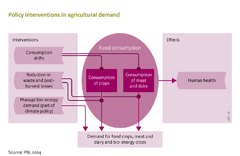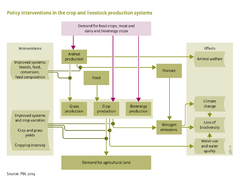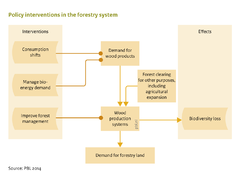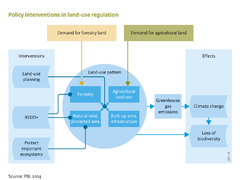Land and biodiversity policies
| Relevant overviews |
Key policy issues
- How can land-use policies contribute to strategies for halting biodiversity loss and reducing greenhouse gas emissions?
- How can changes in consumption patterns contribute to achieving sustainability goals through changes in land use?
- What are the synergies and trade-offs between halting biodiversity loss, food security, reducing nutrient emissions, and reducing water stress?
Introduction
The increase in material wealth, population and economic growth have led to a large demand for agricultural products and transformation of large parts of the land surface. The wide range of environmental issues related to agriculture and forestry include distorted nutrient balances, biodiversity loss, greenhouse gas emissions from land use and land-use change, soil degradation, and water stress due to agricultural water demand. These issues can be addressed from a sector perspective focusing on the respective system (e.g., nutrients, water, see the respective components). However, these issues are linked by demand for land-based products, and by land management.
The IMAGE framework enables a systems approach to analyse policy interventions targeting the impacts of land use on biodiversity and climate change. To identify interventions that could reduce the impacts of agriculture and forestry on the environment, the system takes account of the chain linking demand for food, feed, wood, and bioenergy, to types of production systems and to landscape impacts.
Policy interventions can target demand for commodities (Figure A), the production system, for instance, with respect to efficiency of natural resource use (Figure B and C), or a more systemic approach to regulating land use for different purposes within a landscape (Figure D). Regulation of land use implies managing the land resource base by designating areas to specific purposes, such as excluding protected natural areas from agricultural use, or preventing deforestation. Alternatively, regulation could be in the form of financial incentives to create value for currently non-market ecosystem services, such as emission reduction from deforestation combined with biodiversity conservation (e.g., REDD+ schemes) and other forms of payment for ecosystem services (PES).
While this section focuses on the impacts on biodiversity, climate change, water and nutrient balances, some policy interventions also have implications for other policy domains, such as food security, human health and animal welfare.
Model description
The interventions described in this section are implemented in different parts of the IMAGE 3.2 framework, and are also addressed in the components in which the respective processes are described.
Policies that change demand for agricultural products (Agricultural demand part) are implemented in the agricultural economic model, thus taking into account the impacts on trade and demand in other regions. In IMAGE 3.2, change in wood demand is addressed in the model via a simple relationship with GDP, or by using external input data on wood demand (see Component Agricultural economy). Demand for second-generation bioenergy crops is addressed in the energy model.
Changes in production systems (Agricultural production system part) are modelled in IMAGE using alternative input parameters. For the relevant inputs in e.g. the land-use allocation, livestock, and nutrient modules, these changes are consistent with those in the agro-economic model, to ensure appropriate representation of the (cost) structure of production. Production system changes, for example those induced by taxes or scarcity of endowments, are implemented in the agro-economic model and adjusted in other modules, accordingly.
Land-use regulation (Forestry sector and Land-use regulation part), which is the regulation of land supply, is modelled as a consistent resource constraint in the land-use allocation model and the agro-economic model. This last model takes account of the economic effects of restricted land supply. For example, REDD+ and PES are implemented not as additional productive functions, but by reducing the land supply in the agro-economic model. The spatial dimension of such land-use regulation, like the expansion of protected area, is taken into account in the agricultural systems module, and affects via the resulting land use pattern all down-stream processes.



